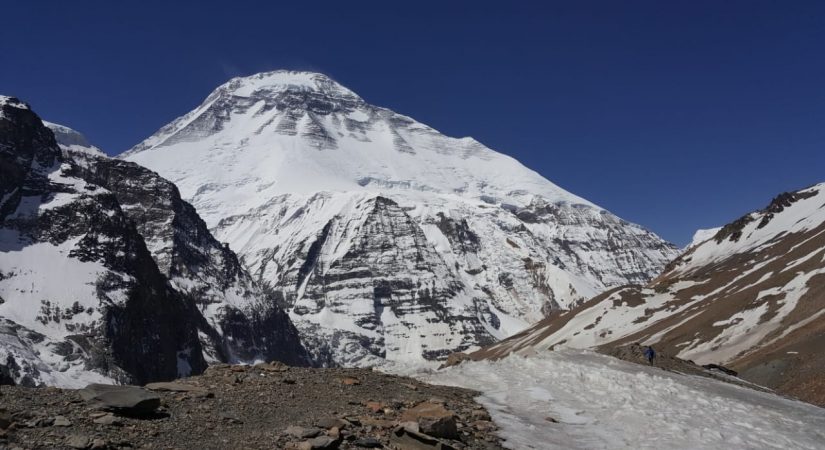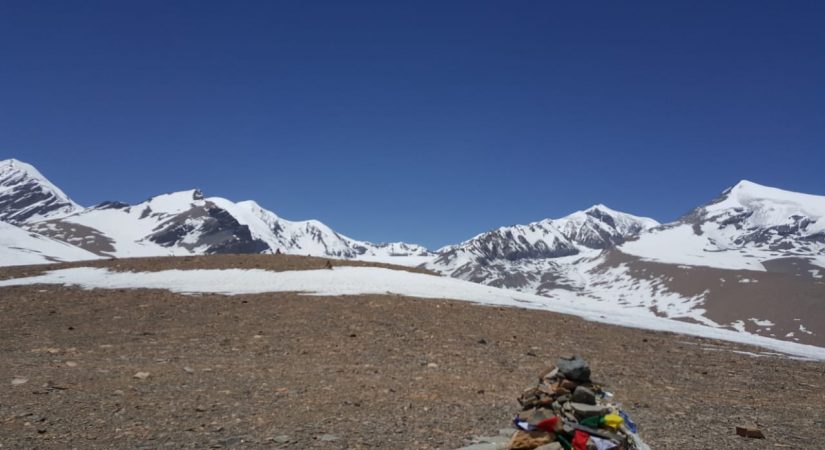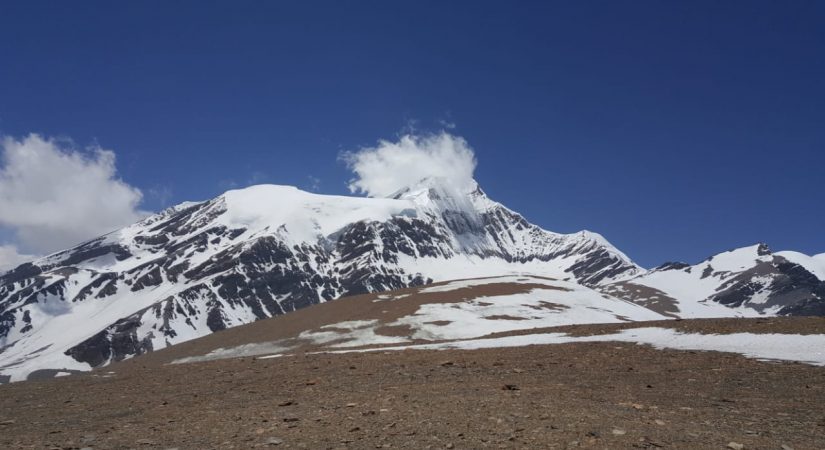2-12 people
Difficult
Tea House / Tent
(5,240m/17,192ft)
B / L / D
Tourist Bus / Jeep
Mar - May & Sept - Nov
Dhaulagiri Base Camp Trek is a challenging trek around the Mt. Dhaulagiri Trek (8,167m / 26,795 ft), the seventh highest Himalayan Peak lying north-west of Pokhara in Western Nepal and south of the Tibet and Nepal border. The Dhaulagiri, along with another Eight-Thousander, the Annapurna, carves the world's deepest gorge of Kaligandaki. The trek also crosses two high passes - the French pass (5,240m/17,192ft) and the Thapa pass (5,155m/16,913ft).
Trip Outline
Day 01: Pokhara and drive BY Jeep to Darbang (1110 meters) via Beni.
Day 02: Trek to Muri (1720 meters).
Day 03: Trek to Boghara (2000 meters).
Day 04: Trek to Dovan (2350 meters).
Day 05: Trek to Sallaghari (3000 meters).
Day 06: Trek to Italian Base Camp (3630m).
Day 07: Acclimatization day at Italian Base Camp.
Day 08: Trek to Glacier Camp (4200 meters).
Day 09: Cross French Pass (5350 meters) and trek to Hidden Valley (5080 meters).
Day 11: Another acclimatization and rest day
Day 12: Summit Dhampus Peak (6012 meters and trek to Hidden Valley (5080 meters)
Day 13 : Cross Dhampus Pass (5244 meters) and trek to Yak Kharka (4700 meters).
Day 14: Trek to Jomsom (2720 meters).
Day 15: Drive to Kathmandu
Detail itinerary
Day 01: Pokhara and drive BY Jeep to Darbang (1110 meters) via Beni
6 Hrs B/L/D Tea House
After breakfast, you head to Beni by Local Bus. You'll find most of the scenery is very enjoyable along the countryside. Beni is the district headquarters and has a police check post where your trekking permits will be examined. The town is at the confluence of the Myagdi Khola and the Kali Gandaki
Day 02: Trek to Muri
6 Hrs B/L/D Tea House / Tent
after crossing the river to its West Bank as you leave Phedi, the trail starts climbing in earnest and there will be many switch-backs until you arrive at the ridge and the angle of ascent eases. Again the trail climbs steeply to the villages of Muri. Continue your trek to Sibang and Mattim. From here you continue up an incline to the snout of the ridge, descend to the Gatti Khola and reach Phalai Gaon (1,810m). Cross the Dhara Khola to once again emerge on the west bank of the Myagdi Khola and then climb a ridge to the large Magar village of Muri.
Day 03: Trek to Boghara
6 Hrs B/L/D Tea House / Tent
Descend a little, cross a stream and continue through terraced fields before climbing a ridge to reach the pass from where you can see Mt. Ghustung South (6,465m). Descend to the Myagdi Khola and trek along its West Bank to the village of Naura from where you will climb a little before traversing a grassy hill and climbing a steep slope with switch-backs, then descend through a forest and terraced fields to Boghara (2,080m).
Day 04: Trek to Dobang
6 Hrs B/L/D Tent
The trail first descends through terraced fields to a small ridge, then through a forest to Jyardan which is the most remote permanent settlement in this part. After the settlement a high winding path crosses a rocky area which then descends before climbing again to Lipshe where there is one single hut. The trail continues through a forest to Lapche Kharka and then climbs to the level area at Dobang.
Day 05: Trek to Sallaghari
5 Hrs B/L/D Tent
After crossing a wooden bridge out of Dobang the trail ascends a forested area. Soon the west face of Dhaulagiri I (8,167m) becomes visible through breaks in the trees. Descend to the Myagdi Khola and cross via a wooden bridge to the east bank continue to Chartare. Passing through forests again, you cut across a rocky area and cross a stream to Choriban Khola.
Day 06: Trek to Italian Base Camp
7 Hrs B/L/D Tent
Follow a trail to the terminal moraine of the Chhonbarban Glacier and enter the glacier from the right. Tukche Peak (6,837m) becomes visible straight ahead; at the far end while the impressive north flank of Dhaulagiri I (8,167m) dominates the skyline to your right. After a short while you will reach Italian Base Camp (3,660m), which is also the site of your camp for the night. To the west are the peaks of Dhaulagiri II (7,751m), Dhaulagiri III (7,715m) and Dhaulagiri V (7,618m).
Day 07: Acclimatization day at Italian Base Camp.
4 Hrs B/L/D Tent
We will spend a day acclimatizing to the thinning of the air. It is recommended that your body acclimatizes to the high altitude and be adjusted for higher altitudes in the days to follow.
Day 08: Trek to Glacier Camp
6 Hrs B/L/D Tent
Set up early in the morning when the weather is expected to be clear. This Trail is prone to stone fall, which passes through a narrow gorge. Today we stay overnight near at glacier
After the glacier you climb two terraced hills, the first of which runs along the glacier, then cuts across the mountain flank and the moraine you enter a gentle incline on the left from an ablation valley. Climb this gentle slope to the French Pass (5,360m). A great vista opens up from the French Pass and you will be able to see Mukut Himal (6,328m), Tashi Kang (6,386m) and Sita Chuchura (6,611m), all of which surround the Hidden Valley. To the south is Tukche Peak (6,920m) and beyond is the massive peak of Dhaulagiri I. From the French Pass you continue along the right edge of the Hidden valley losing a little altitude to the Thapa Pass (5,250m) between Tukche Peak and Thapa Peak (6,012m). Descending from the Thapa Pass you will make it to the camp at 5,200m.
Day 10: Another acclimatization and rest day
3 Hrs B/L/D Tent
Aacclimatization and rest day
Descend from the Hidden Valley to the Dhampus Pass and continue to Yak Kharka. There is a perfect camp site to enjoy the surroundings.
Day 12: Cross Dhampus Pass
6 Hrs B/L/D Tent
Descend from the Hidden Valley to the Dhampus Pass and continue to Yak Kharka. There is a perfect camp site to enjoy the surroundings.
Day 13: Trek to Jomsom
7 Hrs B/L/D Tent
Continue on to the village of Marpha, on the west bank of the Kali Gandaki River. Marpha is home to many apple orchards as well as all various food products made from the fruit. Don't forget to taste the local Apple Brandy a specialty from the region that you may be lucky enough to taste en route. Continue north, up the river valley to the town of Jomsom.
Day 14: Drive to Pokhara
6 Hrs B/L/D Hotel
Day 15: Drive to Kathmandu
7 Hrs B/L
What's included?
- All Transport
- Trekker’s Information Management System(TIMS) card
- All governmental procedure fees, all permits and local taxes and Porter
- All meals and accommodation throughout the trek.
- An experienced English speaking trekking guide possessing valid license issued by the government of Nepal.
- Highly experienced trekking staffs.
- Travel and rescue arrangements.
What's not included?
- Visa fees/ international airfare to and from Kathmandu
- Travel / medical insurance and emergency evacuation cost.
- Hot and cold shower, battery recharge during Everest base camp trek.
- Personal expenses phone calls, bar bills, extra porters, beverages etc.
- Personal Everest base camp trekking equipments/gears.
- Tips for guides, porters and drivers.
- All others expenses not mentioned in “Trip Cost Includes” section








